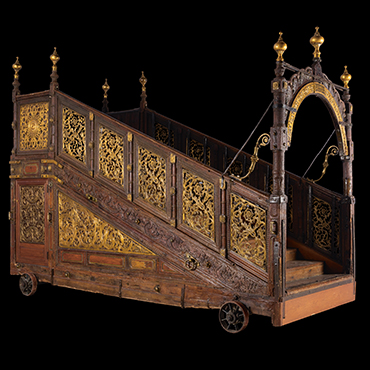Entering the House of God
The sanctity and security of the Ka‘bah have always been of utmost importance. Even before the advent of Islam, the Quraish raised its entrance door more than two meters above the level of the sacred precinct. A staircase was thus needed to gain access, and the tradition was established to equip the staircase with wheels so that it could be stored nearby and moved to the Ka‘bah when required. The example displayed in AlBidayah was a gift to the Ka‘bah from a ruler of Southern India in the AH 1230s/1820s CE.
Dignitaries have always been granted entry into the Ka‘bah, but from at least the 6th century AH/12th century CE, the public was also permitted to enter on certain days of the year—a tradition which continued well into the last century. A wide, movable staircase, known as the madraj, made it possible to have controlled entry. The madraj was also a political symbol, enhancing the reputation of the patron who donated such a prominent object to the Ka‘bah.

This madraj, which is almost 5 meters long and 4 meters high, was commissioned by the Nawab of the Carnatic Sultanate of Southern India (r. AH 1234–40/1819–25 CE), Azam Jah Bahadur Wallajah IV, also known as Muhammad Munawwar Khan Bahadur. Crafted by Sayyid Sibghatullah at the Nawab’s court in Chepauk, India, it features elaborate baroque-inspired motifs, reflecting the Nawab’s fondness for English design.
The East India Company packed and transported the staircase on the ship Holly Lutchmy from Chepauk to Jeddah via Mumbai in AH 1242/1826 CE, together with gifts for the dignitaries of Makkah al-Mukarramah and alms for the poor.
From AH 1297/1880 CE, the staircase stood side by side with another staircase donated by the Nawab of Rampur, India, Kalb Ali Khan (r. AH 1282–1304/1865–87 CE), which was silver-plated. Azam Jah’s madraj was used on days when the Ka‘bah door was opened for men; Kalb Ali Khan’s madraj was reserved for female visitors. By AH 1364–5/1945–46 CE, Kalb Ali Khan’s staircase had deteriorated and was dismantled.
Overleaf:
Ka‘bah staircase (madraj)
Chepauk, India
AH 1240/1824–25 CE
Crafted by Sayyid Sibghatullah for Azam Jah Bahadur Wallajah IV
Teak, iron, brass, steel, copper, gold, ebony,
h. 362 × w. 235 × d. 481 cm
The General Authority for the Care of the Two Holy Mosques
Right:
HM King Saud ascending the historic
staircase at the inauguration of the new kiswah.

